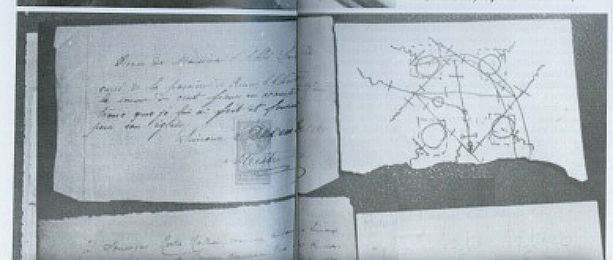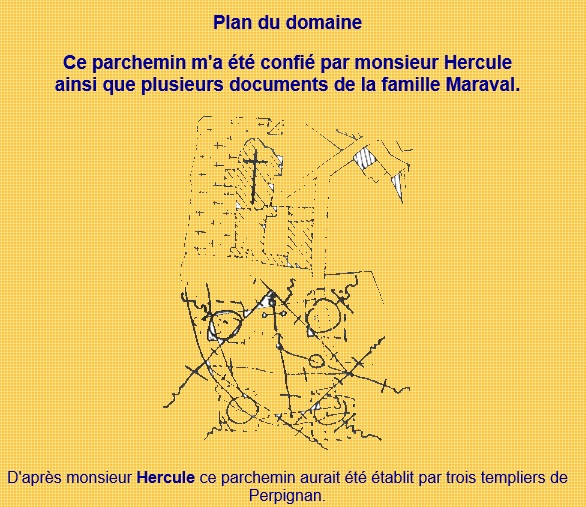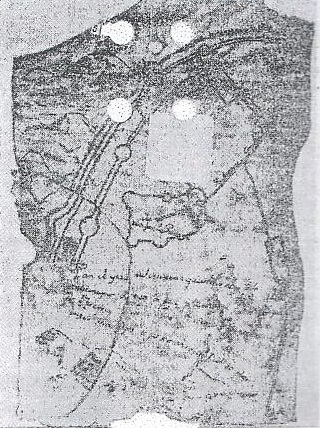Rennes-le-Château and Yves Maraval
No sources, no references
Just stories
Paul Smith
13 October 2018
Those who peddle stories about Yves Maraval and Rennes-le-Château never provide any primary sources or references as back up – they just want their readers to accept everything on face-value. It is claimed that Yves Maraval was one of the early Rennes-le-Château “researchers” during the Noël Corbu period of the 1950s – except there’s nothing in existence about Yves Maraval dating from the 1950s and 1960s.
Here is a Rennes-le-Château treasure map that appeared in Jean-Luc Chaumeil, Le Charivari 18: “Les Archives du Prieuré de Sion”, pages 12-13 (1973), claimed to have been drawn by Bérenger Saunière:

The caption reads as follows: “A sketch drawn by Saunière. The circles at the four corners of the quadrilateral indicate respectively the Tour Magdala, the church of Saint-Madeleine, the Villa Bethania and the Alchemy Tower of the Voisin family's chateau” (Un croquis tracé de la main de l'abbé. Le cercles dessinés aux quatre coins du quadrilatère indiquent la tour Magdala, l'église Sainte-Madeleine, la villa Bethania et la tour d'alchimie du chateau de Voisins).
When asked about this diagram several years ago, Jean-Luc Chaumeil stated he didn’t know either way if it was genuine or a fake. It has not been included in the English translation of Le Charivari 18 that was republished in 2010.
Later, the treasure map appeared on a French website where it was attributed to Yves Maraval – from Bérenger Saunière to Yves Maraval:

The commentary reads as follows: “This parchment was entrusted to me by Monsieur Hercule, along with several documents relating to the Maraval family. According to Monsieur Hercule this parchment could have been drawn up by three Templars from Perpignan. We could therefore conclude that Saunière designed the layout of his estate using his own parchments as a guide. Several almost identical parchments are in circulation, but are any of them authentic? We cannot provide any convincing proof – everyone is entitled to their own opinion” (Ce parchemin m'a été confié par monsieur Hercule ainsi que plusieurs documents de la famille Maraval. D'après monsieur Hercule ce parchemin aurait été établit par trois templiers de Perpignan. Nous pourrions donc en tirer la conclusion que Béranger Saunière aurait construit son domaine en s'appuyant sur ses parchemins, plusieurs parchemins à peu près identiques circulent, sont ils authentiques? Nous ne pouvons en apporter la preuve, à chacun son opinion).
Raymond Sagarzazu claims that Gérard Dutriat told him that Yves Maraval gave the above map to Quebec researcher Bernard Sorrieule (the world is full of believers in mysteries and treasures not interested in the evidence of Saunière’s 250,000 francs raised from trafficking in masses, because the rational explanation is so boring – that’s how such apocryphal stories get started).
Fake Rennes-le-Château treasure maps are not uncommon. Below is the earliest known fake treasure map relating to the story of Bérenger Saunière, first published in the article “Butin des Templiers? Paye des armées royales? Le trésor légendaire de Rennes-le-Château est-il sur le point d’être découvert?", in L'Indépendant, 13 August 1962 (Archives de l’Aude, Carcassonne, 31 J 69).

It was described as the “parchment of Brother Dominque de Mirepoix” and dated “25 Juin 1249”. It was planted as a hoax to dupe Jacques Cholet during his excavations (found by his excavation partner Rolland Domergue) and it succeeded – Cholet described it as genuine in his report dated 25 April 1967.
Quoting Jacques Cholet:
“The whole document is dated and signed by Brother Dominique de Mirepoix on 29 June 1249. The signatory says that he assisted the Lady Regent in burying her baggage and drew the plan on her orders... He [Rolland Domergue] used explosives to remove the cover of a well situated on his property. It was there that he found the parchment of Dominique de Mirepoix” (Sur ce parchemin il y a deux écritures: l'une molle. etpassée qui forme le tracé et le texte principal, le toutdaté et signé par le Frère Dominique de Mirepoix, le 29 Juin1249. Le signataire dit qu'il a assisté, Dame Régente, àenfouir ses bagages et rédigé le plan sur son ordre.... Il [Rolland Domergue] fait sauter à l'explosif le bouchon d'un puits situédans sa propriété, c'est là qu'il trouve le parchemin de Dominique de Mirepoix).
|


